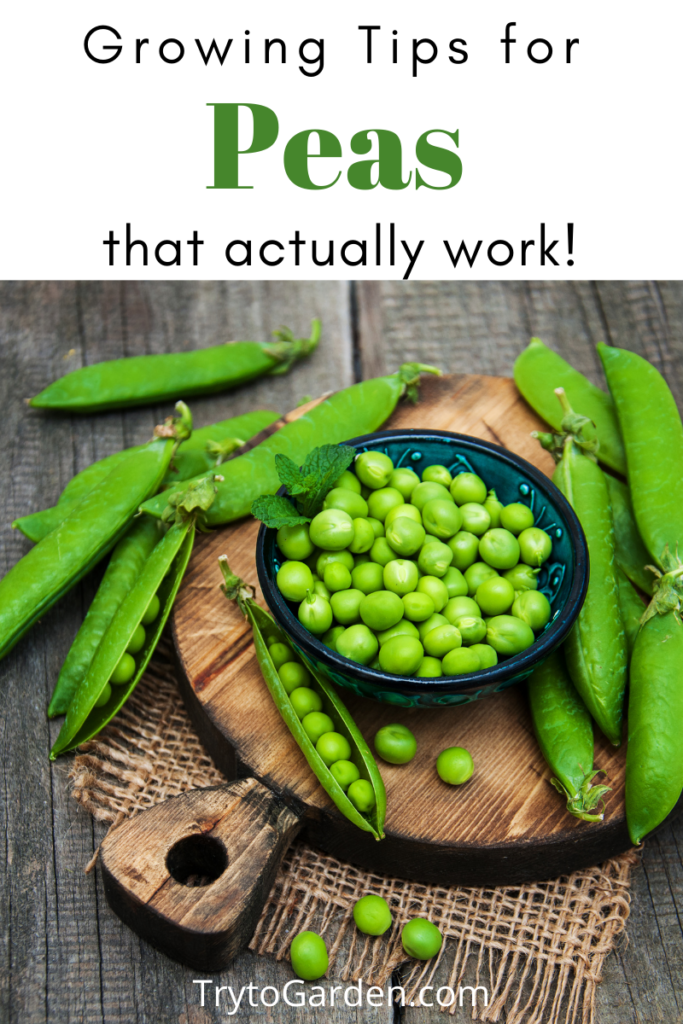This post contains affiliate links, which means I will make a commission at no extra cost to you should you click through and make a purchase. As an Amazon Associate I earn from qualifying purchases.
Peas are one of the earliest fruits that can be planted in the garden after the winter snows melt and the ground can be worked, or they can be one of the last crops planted in late summer. Yes, I said fruit.

According to Wikipedia:
The pea is most commonly the small spherical seed or the seed-pod of the pod fruit Pisum sativum. Each pod contains several peas, which can be green or yellow. Botanically, pea pods are fruit, since they contain seeds and develop from the ovary of a (pea) flower.
Regardless, they are easy to grow, an important addition in many recipes or served as an individual dish, and provide a host of health benefits.
Gardening Tips for Peas That Actually Work!
There are upwards of 1,000 known varieties of peas, one of the earliest crops grown since the beginning of written records. The Greeks and Romans cultivated the legume; it was an important crop throughout the Middle Ages and later in colonial America.
While there are many varieties available, there are basically three kinds of peas, English, snap peas, and sugar peas. They can be bush plants, which still like a little support in the garden, or a vine crop plant so they can grow up a fence or a trellis. Each variety has a particular purpose, fresh eating, canning, and freezing, or for use in soup.
Benefits of Peas
Peas are legumes and supply eight different vitamins, including vitamin K1, an important vitamin for bone health, the vitamin B complex, and vitamins A and C, seven different minerals, dietary fiber, and proteins.
Peas are a good source of vitamins C and E, zinc, and other antioxidants that strengthen your immune system. Other nutrients, such as vitamins A and B and coumestrol, help reduce inflammation and lower your risk of chronic conditions, including diabetes, heart disease, and arthritis.
Basic Peas Facts:
Typically germination occurs between 7 and 14 days.
The key to growing peas is to plant them early enough in spring so they mature while the weather is still cool. This means planting in February, March, or April in most parts of the United States and Canada. They can even be grown as a fall or winter crop in warm areas of the U.S.
Peas are frost tolerant and germinate best in cool soil, so they should be planted in very early spring as soon as your garden soil is workable. The optimum soil temperature for pea germination is 40 to 70° F. If the soil is too cold (below 40 degrees), seeds take much longer to germinate and may rot.
This is tough as they suggest 15-10 plants per person that you plan on eating them. The more you pick them, the more peas you'll have to pick.
Raw or cooked. There is nothing like fresh peas taken from the pod. They are so sweet and tender that they are a great addition to any salad. However, peas are used in a number of cooked dishes from soups to side dishes.
In general, the majority of peas are cold-weather crops and do not produce well during the heat of summer. Early or late freezes or snowfalls don't bother the plant. Maturity dates range anywhere between 50 to 80 days. In this northern garden Zone 5A, peas generally planted around the first day of spring, March 21st, are in full production around Memorial Day or even before, depending on weather conditions.
Peas, like the vast majority of vegetables, like fertile soil. The plants thrive when compost or organic fertilizers are added, but be sure to mix well the fertilizers used into the soil. Peas also like well-drained soil and are planted in a sunny garden location.
Peas do best in raised beds or soil which has been mounded to avoid water clogging. The two critical times when water can reduce yields are during flowering and the time period when the pods begin to swell. After that, they are not very fussy.
Pea roots gather nitrogen from the soil, so in general, nitrogen applications are unnecessary. Avoid planting where other nitrogen-fixing plants (legumes), like beans, grew before. The pea plant does best when the soil Ph is 6.5; an application of lime then should be considered to increase the yield.
Weeding is also important for the pea plant, similar to most garden vegetables. Particular care should be used as not to damage any of the roots of the plant.
There are a number of different varieties available. One personal preference is a variety called Alaska. It is an early pea, about 50 -55 days depending on weather conditions, it produces good harvests, doesn't mind a cold snap or two, and is easier to pick off of a fence, saving garden space. There are a lot of other vine types available to choose from, which may suit your location better.
Like any garden vegetable, it is a lot of trial and error. It is always a good step to research what is the best variety for a certain locale and determine how you want to use the harvest. After that, it is basic garden common sense to plant. Pick and enjoy one of the healthiest and easiest vegetables to grow.
Easy Recipe for Peas
Peas are so incredibly versatile - we have done everything from Pasta with Peas and Pancetta to Creamed Peas ourselves - even a quick Pea and Peanut Salad that is great for hot summer days.
I found this great stew recipe that uses peas:
